JUST Report
The State of Health and Safety: One Year Later, Increased Workplace Health and Safety Measures Are Still Needed
- More Reports
- View All News & Reports on Workers
- View all JUST Reports
Executive Summary
In this latest survey conducted by JUST Capital and The Harris Poll, with support from the Ford Foundation, we explore the state of worker health and safety in the U.S., turning to both employers and employees to understand how the impacts of COVID-19 are continuing to shape the workplace one year into the pandemic. Explore our key takeaways, as well as the full findings of this report, below:
- Safety is directly tied to health outcomes, long-term equity issues, and resilience of companies.
- One year after COVID-19 began to disrupt all facets of society, there remains serious disagreement between workers and employers if workplaces are safe. Throughout the survey, workers reported experiencing lower levels of health and safety protections than employers reported providing.
- Nearly 30% of workers do not feel safe and protected from contracting the coronavirus at their current workplace.
- Workers are more than twice as likely as employers to report that management does the minimum required to keep workers healthy and safe (32% vs. 14%) and that workers’ health and safety often takes a back seat to profits (37% v 19%).
- One in five workers report going to work sick since the start of the pandemic. Of that group, 67% did so because of either a lack of sick leave, fear of losing their jobs, or fear of employer anger.
- Racial inequities were exacerbated by the crisis: respondents identifying as Hispanic are more than 2x more likely to say that they have been discouraged from reporting sickness (28% vs 13% overall) and both Hispanic and Black Americans are disproportionately more likely to say they fear negative, personal impact if they were to report on safety issues in the workplace.
- Workers in the Healthcare industry report the highest rates of health and safety policies and compliance. Retail stands out as an industry that’s lagging behind.
- Gig and temporary workers report the greatest feelings of lack of safety and support. 57% of gig and multiple job holders say that either they, or someone else in their organization, has been discouraged from reporting injury or sickness, versus 15% of single job holders.
- As states start to roll back mask mandates, it is crucial to note that when asked to identify the “single most important” thing their company could do to make employees feel comfortable at work during the coronavirus pandemic, enforcing mask-wearing was the most-mentioned (verbatim) response from both workers and employers alike.
- Although policies and procedures are essential to mitigating the spread of COVID-19 in the workplace, not involving workers in the creation of these policies can result in workers feeling like they have a lack of agency in the process, and thus may be faced with inadequate solutions for specific needs. One in four are afraid of repercussions if they report on safety issues.
One Year Later
For the last 12 months, the coronavirus pandemic has disrupted the workplace as we know it. On March 11, 2020 the World Health Organization characterized COVID-19 as a global pandemic, and on March 13, President Trump declared a national emergency. The need for companies to respond to the coronavirus crisis came on fast and frantic, forcing many organizations to quickly implement policies and procedures that would protect their workers from exposure and illness.
For some businesses, simply offering a generous work from home policy was sufficient to keep certain workers safe. However, in the U.S. there are approximately 55 million workers in industries deemed either “essential” (including Healthcare, Food Service, and Public Transportation, among others) or whose nature of work otherwise requires that they work outside the home. Taking the possibility of extended home quarantining off the table for this group leads potentially to COVID-19 exposure from any number of individuals, be they co-workers, customers, patients, or the public at large.
And these impacts are felt most keenly among low-wage workers, women, and people of color. Black and Hispanic workers, in particular, have borne the brunt of these challenges on the front lines, comprising about a third of essential workers. And against the backdrop of systemic racism and economic inequality, Black communities have faced considerably higher risk to contracting and dying from COVID-19. As we cross the one-year mark of the pandemic, it only grows more urgent, particularly for workers of color, that companies prioritize health and safety in the workplace.
Throughout 2020, JUST Capital continually turned to the public to find out what they wanted to see corporate America prioritize in the face of COVID-19. As the pandemic evolved, Americans told us what they thought should be prioritized during the initial response and sporadic reopenings – as well as what policies should be altered and prioritized in the long term as we work toward a “great reset” and economy that better serves its workers, customers, and communities. Health and safety consistently topped their chief concerns.
In this latest survey report, we look at policies and procedures in the workplace for those working at least part time away from the home – those most likely to be exposed to illness. We spoke with both workers and business leaders across companies of multiple sizes and industries to fundamentally understand if there was a disparity between workers feeling safe and how employers see their policies impacting worker safety. Specifically, we (1) asked about what safety policies and procedures are in place, (2) assessed the perceived level of compliance with these policies, (3) evaluated their perceived effectiveness, and finally (4) looked to understand the degree of sickness in the workplace and trepidation of reporting. Finally, we’ll see what the lasting impact these worker health and wellness policies have once the pandemic has receded.
This survey was conducted by JUST Capital and The Harris Poll with support from the Ford Foundation and additional participation from the National Council for Occupational Safety and Health (NCOSH). Throughout the report we will be using the shorthand “workers” to refer to U.S. adults (18 or older) who work full or part time at a company with 25 or more employees, and work outside the home at least part of the time. When we discuss employers, we will be referring to U.S. adults who work full time at a company with 25 or more employees, hold a management level position, have decision-making responsibility for worker and/or workplace issues, and whose employees must work outside the home at least some of the time.
The Experience So Far
At the start of the pandemic there were a lot of unknowns: how long would it last? How bad will it get? When will a vaccine become available? Regardless of when those questions could be answered, employers recognized that they had to respond quickly to protect and support their workforces. For many companies, that response could take the form of liberal work from home policies. For instance, a June 2020 snapshot from Stanford estimates that 42% of the U.S. workforce is working from home during the pandemic, and a September poll by Gallup reports that one in three workers say they are “always working from home.” But for those businesses whose operations require employees to be onsite (often deemed frontline or “essential”), protecting the health and safety of those workers was of vital importance. The public agreed; according to polling that JUST executed early in the pandemic, Americans said the topmost priorities for large companies in response to COVID-19 should focus on measures that protect their workforces.
Our ongoing survey research found that public opinion about corporate responses to COVID-19 was generally strong in the early days of the pandemic, with a majority (58%) saying America’s largest companies were showing leadership during the outbreak. This generally tracks with worker and employer perceptions of safety and protection almost one year later. Across a mix of company sizes, industries, and work situations, the findings are encouraging, with majorities of workers (72%) and employers (76%) reporting feeling safe in their workplace. Yet that leaves 28% of workers and 24% of employers saying that they do not feel safe and protected from getting infected with the coronavirus at their current workplace.
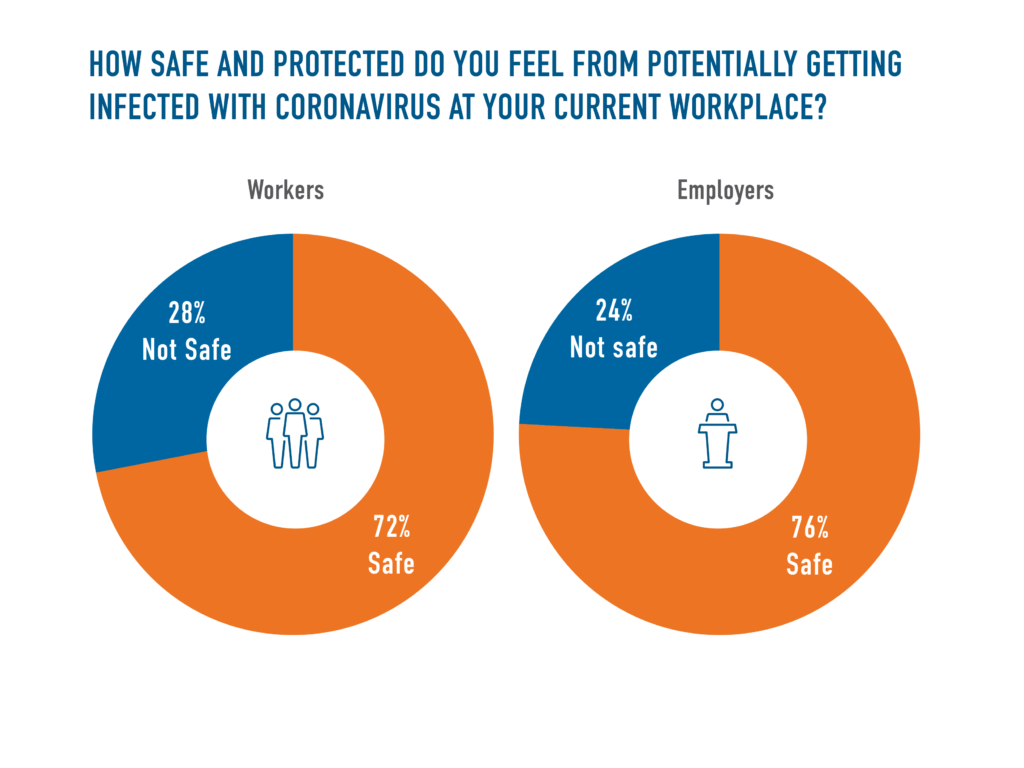
Clearly some employers are falling short in adequately protecting their workforces. Looking at the response groups, the workers who report feeling less safe are concentrated in smaller businesses (with 25-99 employees) in sectors like Retail and Restaurants, who report having frontline or essential positions where they are more likely to interact with the public and therefore have a greater risk of exposure to infected individuals.
The perception of safety is a question of adequacy: those who do not feel safe in their workplace are almost 4x as likely to say that their company’s health and safety measures are not enough to combat the spread of coronavirus. Fewer report that management is sufficiently equipping workforces with protective gear and that compliance with these measures is lagging. To make matters worse, this group is disproportionately more likely to report that they or someone at their organization have been discouraged from reporting an injury or sickness, and fear personal retribution if they were to report on safety issues in the workplace.
Workers and Employers Don’t See Eye to Eye
One theme emerging from the data is the divergence of the perceptions of health and safety between workers and their employers. We asked both groups for their opinions about the degree to which management is taking seriously the needs of workers, and while a majority of workers had positive opinions about their employers’ response, in many cases, workers were significantly more likely – in some cases more than twice as likely – to report that employers are falling behind. This could manifest as workers’ overall skepticism about management’s commitment to their health, safety, and overall well-being.
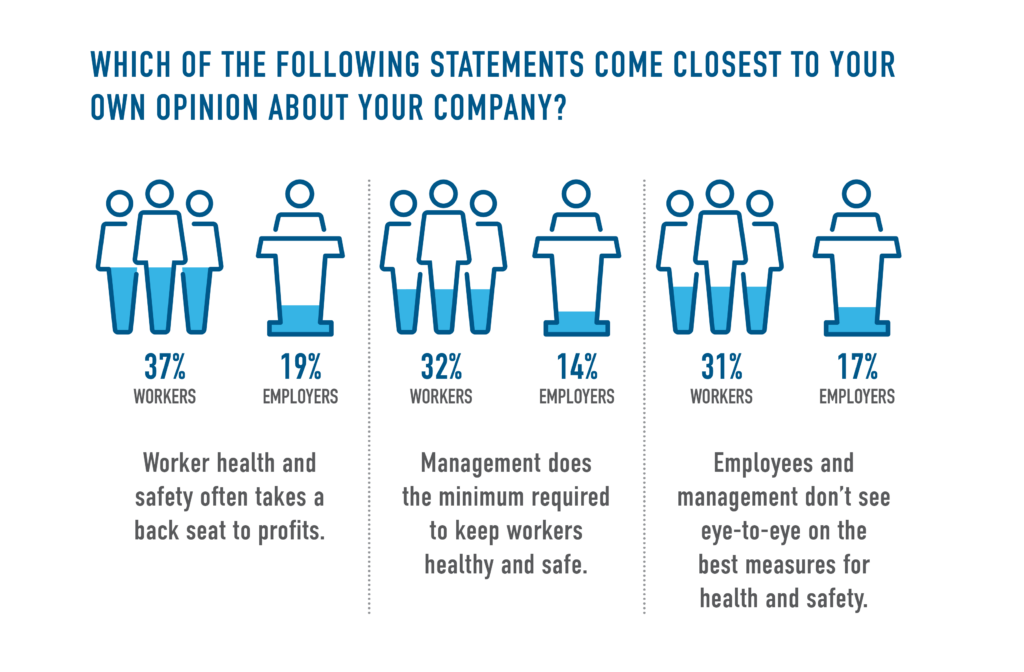
Plans and Procedures
It continues to be of key importance that employers – particularly those in service sectors (e.g. Retail, Hospitality, and Food Services) that are more vulnerable to the virus – provide safe working environments, especially as we tiptoe toward a more significant level of reopening.
Significant majorities of respondents in both the employer (89%) and worker (82%) groups say that their workplaces have a formal, written COVID-19 safety plan in place for employees, and nine in 10 workers report that they are very or somewhat knowledgeable about the plan. What is more, the following chart shows that companies are doing a relatively satisfactory job in communicating those plans to staff.
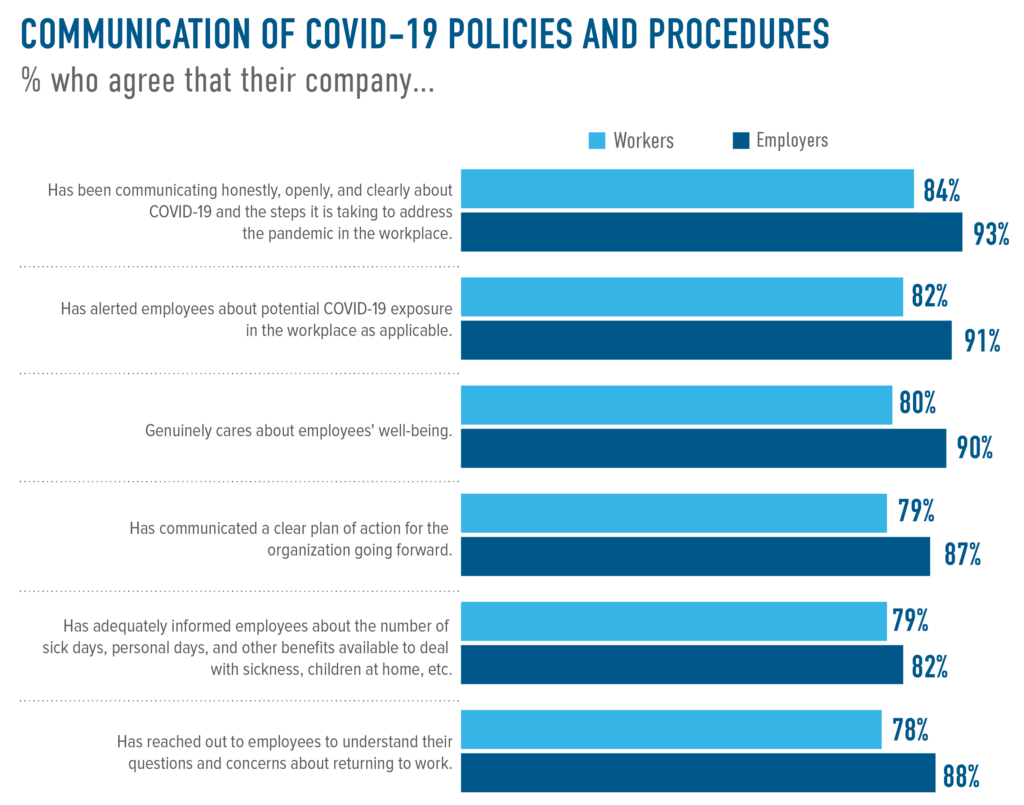
These findings are encouraging, yet subsequent data show that organizational leaders are failing to bring their employees into the planning process. Part-time workers as well as employees of small businesses in particular say they are less knowledgeable about company policies and procedures, which could signal that management needs to create more opportunities for two-way communication and collaborative forums (for example, 67% of part-time workers agree management has “reached out to employees to understand their questions and concerns about returning to work” vs. 80% agreement among full-time employees). Just under half (47%) of employers report creating a task force to manage coronavirus response, and significantly fewer in the worker group than the employer group say that management has asked employees for suggestions or feedback when creating policies and procedures.
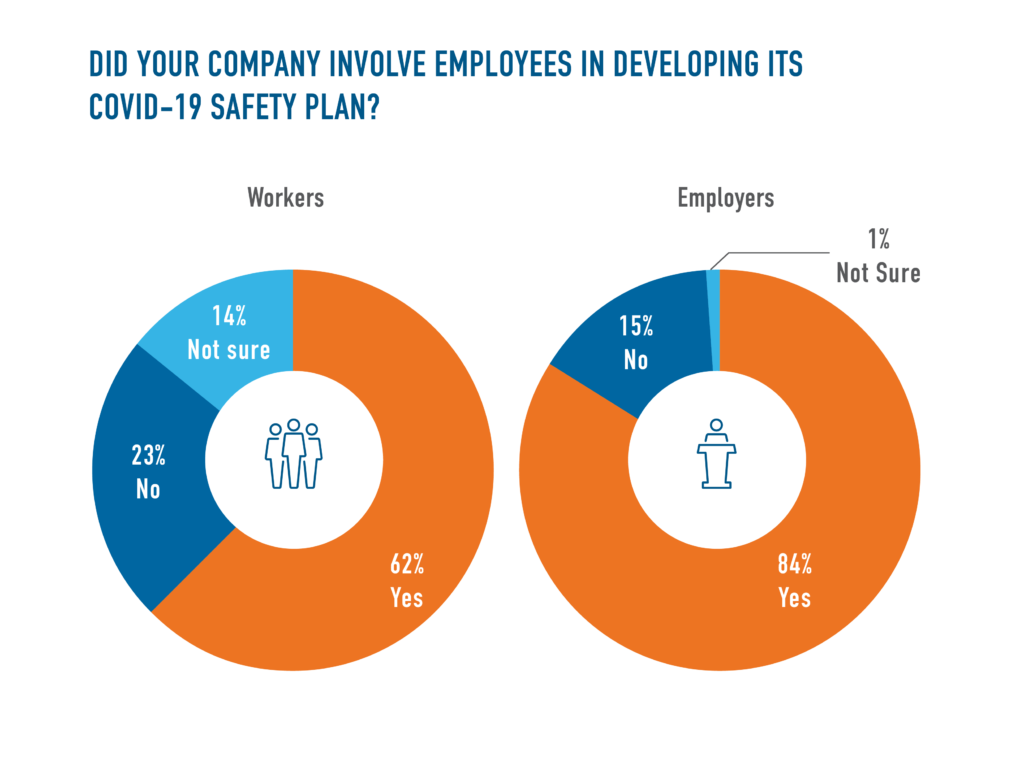
Worker respondents who reported not feeling safe are even less likely to say they have been involved in the creation of a workforce safety plan, and are more likely to say they are “not knowledgeable” of the policies instituted. Although policies and procedures are essential to mitigating the spread of COVID-19 in the workplace, excluding workers from the creation of these policies can lead to a lack of agency for those workers, keeping their unique perspectives from the process of identifying specific needs and solutions.
Policies and Compliance
As stated by both workers and employers alike, the majority of businesses report they have taken fundamental health and safety measures, such as regular cleaning/sanitizing, providing PPE, and enforcing social distancing protocols for customers. Indeed, when asked to provide the single most important step a company can take to make employees feel comfortable in the workplace during the pandemic, majorities mentioned those measures verbatim. Mask requirements, which, while majorities of both employees and employers report are instituted in their workplaces, remain an area where improvement is still needed, especially as mask-wearing enforcement can be an easy step to take.
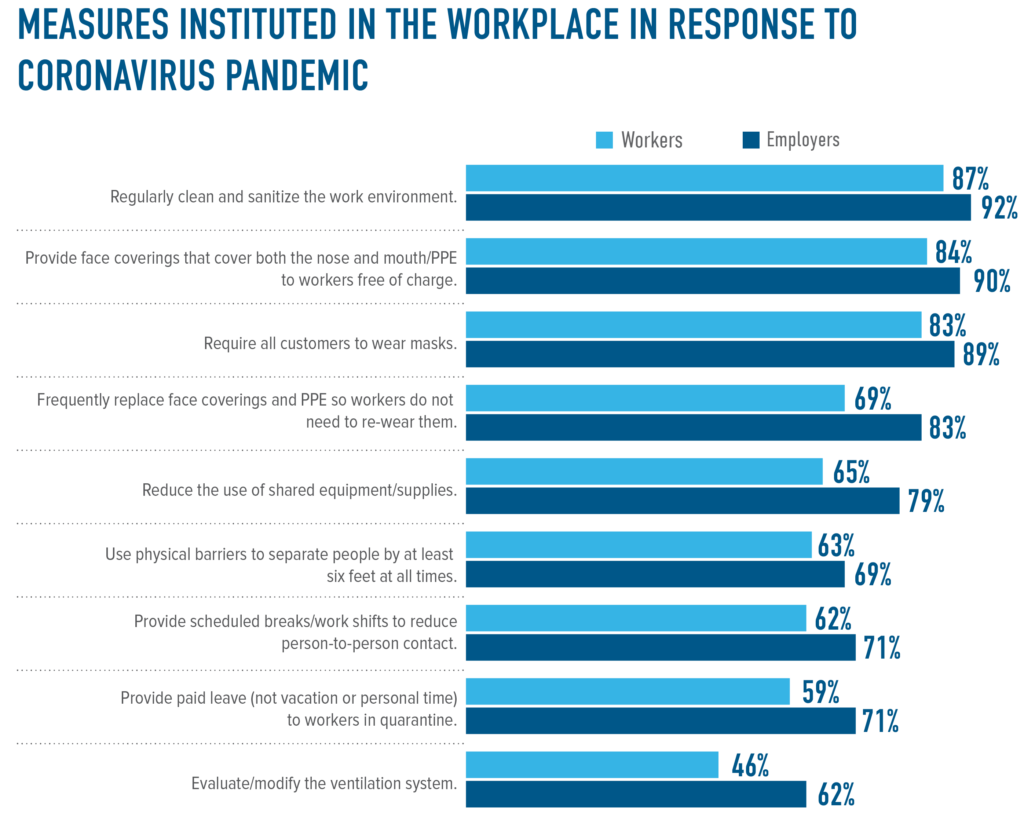
As states start to roll back mask mandates, it is crucial to note that when asked to identify the “single most important” thing their company could do to make employees feel comfortable at work during the coronavirus pandemic, the most-mentioned policy from both workers and employers was to enforce wearing a mask at all times.
Looking across industries, Healthcare is one area where these policies and procedures are reported at a greater rate. Healthcare workers report having their place of business outfitted with revamped ventilation systems, as well as having access to paid leave, regularly scheduled breaks/work shifts to reduce person-to-person contact, and physical barriers to enforce distancing, all by a margin of about 10+ percentage points over the average. In addition, almost three-quarters of frontline healthcare workers said they were involved in the establishment of policies and procedures, versus 56% among those who are not healthcare frontliners.
On the flip side, Retail is an industry that is lagging behind the norm: significantly more workers in this sector agree “management is doing the minimum required to keep workers healthy and safe” (45% Retail workers vs. 32% total) and “worker health and safety often takes a back seat to profits” (43% Retail workers vs. 37% total).
Fewer workers than employers say there are established policies in place for some key health and safety issues – including frequently replacing PPE and reducing the use of shared equipment. Another area in which significantly fewer workers and business leaders reported being aware of an established policy focused on modifications to ventilation systems, which the CDC and numerous epidemiologists recommend as a key strategy to reduce exposure to COVID-19.
Offering paid leave to quarantining employees is another area where there is a marked discrepancy between what managers are saying they provide and whether workers share the perception that the policy exists. While 71% of employers say they provide paid sick leave to workers in quarantine, 59% of workers share that this has been their experience, and we know from our research that just 20% of America’s largest companies have expanded their paid sick leave policies as a result of the pandemic.
We see a rosier picture when we look at whether respondents are satisfied with the degree of compliance employers maintain with these health and safety measures. Among those who say any of these measures are in place, more than three-quarters are “very or somewhat” satisfied with compliance.
When we ask respondents whether they feel the health and safety measures in their workplace are adequate to combat the spread of coronavirus, majorities of both workers (69%) and employers (82%) tell us the level is just about right. Most assess policies and procedures positively, with more than eight in 10 saying they are effective and easy to adhere to; among the negative assessments, there is tight agreement on both sides that said policies might be interfering with company productivity.
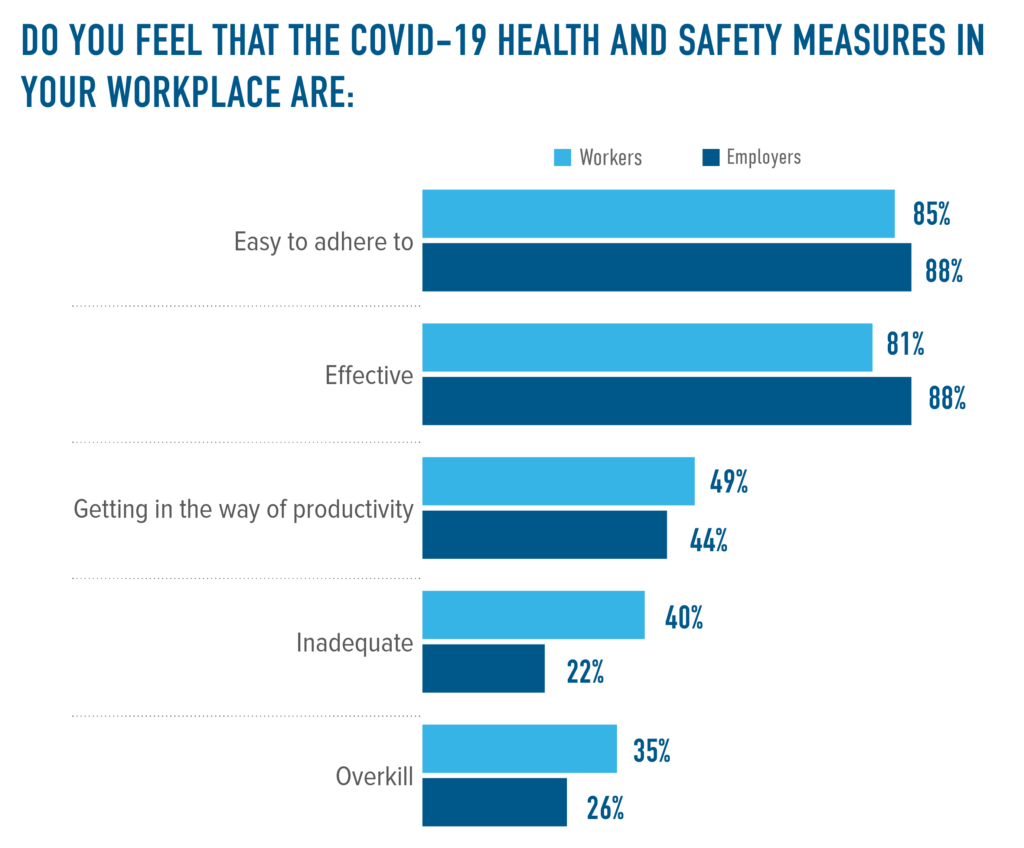
Gig workers and those who have more than one job are more vulnerable to exposure and, on the whole, are more likely to agree that health and safety measures in their workplaces are inadequate to combat the spread of the coronavirus, making them more fearful of contracting COVID-19. Gig workers and multiple job holders have disproportionately reported coming to work sick (34% vs. 13% single job holders), as well as having been discouraged (either themselves or someone else at their business) from reporting injury or sickness by management (57% vs. 15% single job holders).
Sickness in the Workplace
Health and safety policies can be effective in keeping the workplace safe, yet workplace transmission is far from a rare occurrence, as there continues to be significant risk of COVID-19 exposure to those who work in public spaces. Here, we look at incidences of workplace illness and employer response.
One in five workers report going to work sick since the start of the pandemic. Of that group, 33% say they were afraid of losing their job, 32% said they had no paid sick leave, and 28% were afraid of making their employer/boss angry. Also concerns of retaliation are real: 28% said they or another person at their organization were discouraged from reporting an injury or sickness in the workplace.
When looking at COVID-related illness specifically, just 13% of the worker group tell us they have tested positive, and of those 130 workers, only 21 did not tell their bosses about their illness (warehouse workers are more than twice as likely not to have reported illness to their employer). On the positive side, for those who did alert their managers, the response was mostly supportive: half of workers who tested positive said that their employer told them to take time off with pay.
However, a substantial proportion (39%) of sick workers report that management threatened them with some form of retaliation – either endangering employees’ financial health (being told to take time off without pay), putting others at risk (being told to keep quiet about it), or threatening to fire the sick individual.
The reported lack of paid sick leave is a serious barrier to ensuring health and safety, with one in three workers reporting going to work sick because their place of business does not offer the benefit. Echoing these findings, in a recent Fortune op-ed titled “To end the pandemic, every business leader must put worker health and equity first,” Ford Foundation’s Darren Walker and Cisco’s Chuck Robbins underscored, “Over a quarter of people know someone who has gone to work sick during the pandemic because of financial stresses, thereby risking the health of customers and staff.” Workers must not be forced to choose between their economic security and their health or the health of others. Businesses of all sizes must establish practices that protect their employees financially as well as their health and safety. Our survey also found that companies may be lagging in monitoring these wider health impacts, with only 30% of workers who tested positive saying their employers conducted contact tracing to determine the impact at work.
Health and safety issues also exacerbated racial inequities. Multiple studies have shown that Black/African American and Hispanic workers account for about a third of employees in frontline jobs. Our research shows that these groups are more likely to report experiencing retaliation by managers for raising concerns about the coronavirus: Hispanics are 2x more likely to say have been discouraged from reporting illness (28% vs 13% overall) and both Hispanics and Black Americans are disproportionately more likely to say they fear negative, personal impact if they were to report on safety issues in the workplace.
The Road Ahead
We now know how susceptible we are to pandemics and health crises, as well as their impact on communities, the economy, and business success. With increasing numbers of Americans receiving vaccinations every day, companies have reason to feel optimistic about the state of business in 2021. The Conference Board’s annual CEO Confidence Index reflects record levels of confidence among leaders of the country’s biggest companies. With some states starting to roll back COVID-19 restrictions and mask mandates, we’re entering into a confusing period for employers, workers, and the public. What this report shows is that now is not the time for leaders to start pumping the brakes on their coronavirus precautions. Eight in 10 leaders agree that COVID-related logistics will transition to permanent policies in their company, and over the next six months, one in three tell us they plan to increase workplace health and safety initiatives at their company.
The simple measure of extending paid sick leave to all workers, whether full-time, part-time, or contract-based, is one of the most impactful ways businesses can help reduce the transmission of COVID-related illness. This report also underscores the difference between having a paid sick leave policy on paper vs. implementing a policy that is easily accessible to all, understood by all, and does not result in retribution or criticism from management when utilized. 59% of workers say their companies provide paid leave (not vacation or personal time) to workers in quarantine, with the lowest incidences among small businesses, retail companies, and manufacturers. And a majority of employers admit they have separate health and safety policies for their fully employed workforce vs. temporary or freelance workers.
To build resilience, employers should think long-term when it comes to health and safety. This means upholding the policies that have worked in this pandemic even when it’s over, including paid sick leave, employee engagement, and higher pay for frontline workers, contracted employees, and temporary workers. It’s clear from our survey research on these issues that business leaders should focus on their people, placing their voices, health, safety, and equity at the top of business priorities. There is a critical opportunity today for companies to get this right, lead by example, and help create a safer, more equitable future for all Americans.
Methodology & Attribution
This survey was conducted by JUST Capital and The Harris Poll with support from the Ford Foundation and additional participation from the National Council for Occupational Safety and Health. The survey was conducted online in the U.S. and fielded between February 2nd and 9th 2021, among 1,000 U.S. employees and 300 U.S. employers. To qualify, U.S. employees must be 18 or older, work full or part time at a company with 25 or more employees, and work outside the home at least part of the time. U.S. employers must be 18 or older, work full time at a company with 25 or more employees, hold a management level position, have decision-making responsibility for worker and/or workplace issues, and employees must work outside the home at least some of the time. This online survey is not based on a probability sample and therefore no estimate of theoretical sampling error can be calculated. For complete survey methodology, including weighting variables and subgroup sample sizes, please contact either Jennifer Tonti, Managing Director, Survey Research & Insights or Jill Mizell, Director of Survey Research.
